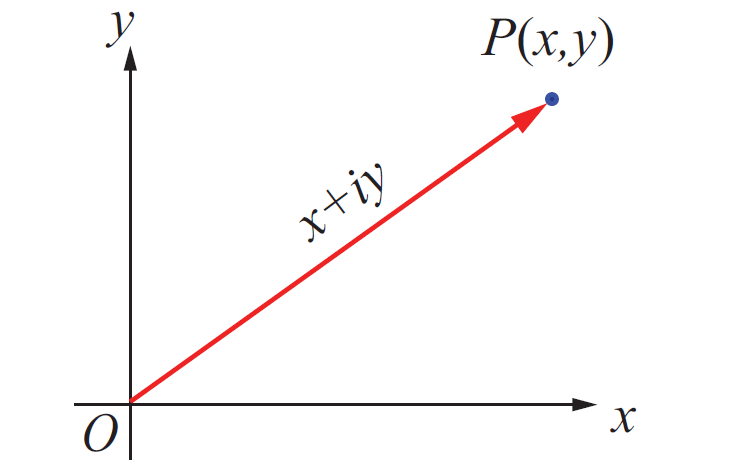NON TERMINATING REPEATING DECIMAL
What is non terminating repeating decimal ?
A decimal number that continues infinitely with repeated pattern.
Examples :
23.562562562 ............. (Repeated pattern is 562)
1.3333333333 ............. (Repeated pattern is 3)
2.365636563656 ............. (Repeated pattern is 3656)
In the above three examples, digits after the decimal point continue infinitely with a repeated pattern.
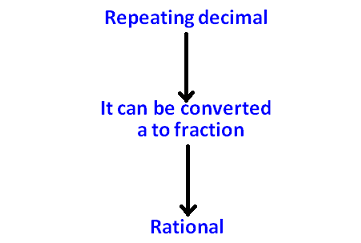
How do we have this non terminating repeating decimal in math ?
When we divide an integer by another integer, we may get the result in different forms.
In those results, non terminating repeating decimal is one of the forms.
Let us consider the fraction 125/99.
When we divide 125 by 99, we get "Non terminating repeating decimal".
It has been explained below.
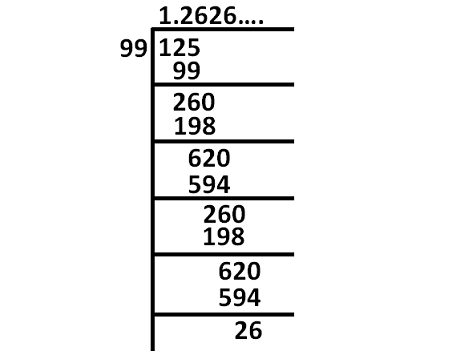
From the above long division, we can clearly understand how we have non terminating repeating decimal.
Therefore,
125/99 = 1.262626 ..........
When we divide 125 by 99, the digits after the decimal keep going infinitely and the repeated pattern is 26.
How to Convert Non Terminating Repeating Decimal to Fraction
Step 1 :
Let x = Given decimal number
For example, if the given decimal number is 2.03434......... then, let x = 2.03434...........
Step 2 :
Identify the repeated pattern
For example, in 2.03434..........., the repeated pattern is 34
(Because 34 is being repeated)
Step 3 :
Identify the first repeated pattern and second repeated pattern as as explained in the example given below.
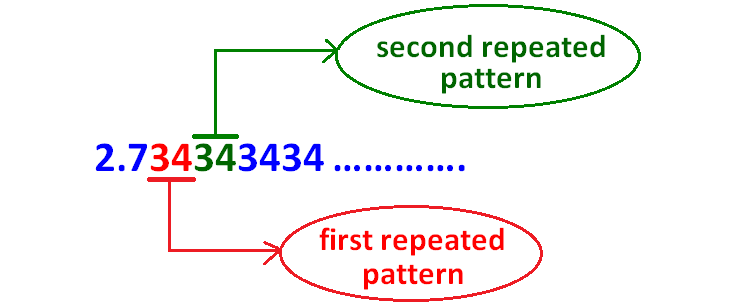
Step 4 :
Count the number of digits between the decimal point and first repeated pattern as given in the picture below.
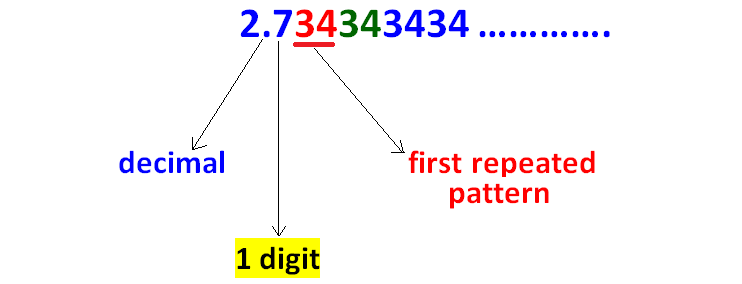
Step 5 :
Since there is 1 digit between the decimal point and the first repeated pattern, we have to multiply the given decimal by 10 as given in the picture below.
(If there are two digits ----> multiply by 100, three digits ----> multiply by 1000 and so on)

Note :
In (1), we have only repeated patterns after the decimal.
Step 6 :
Count the number of digits between the decimal point and second repeated pattern as given in the picture below.
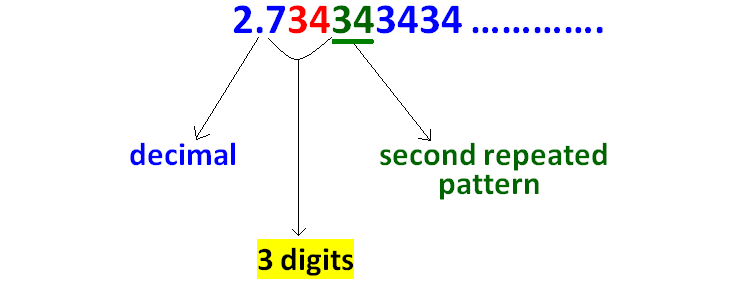
Step 7 :
Since there are 3 digits between the decimal point and the second repeated pattern, we have to multiply the given decimal by 1000 as given in the picture below.

Note :
In (2), we have only repeated patterns after the decimal.
Step 8 :
Now, we have to subtract the result of step 5 from step 7 as given in the picture below.
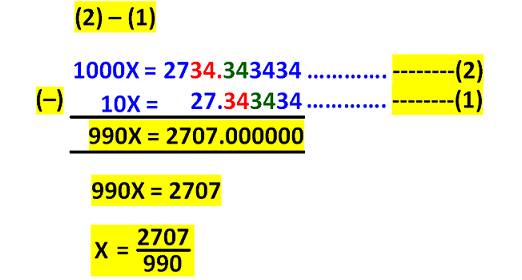
Now we got the fraction which is equal to the given decimal

Solved Problems
Covert each of the following non terminating repeating decimal to a fraction :
Problem 1 :
32.03256256256..........
Solution :
Let x = 32.03256256256.............
Here, the repeated pattern is 256.
No. of digits between the 1st repeated pattern and decimal = 2.
So, multiply the given decimal by 100. Then, we have
100x = 3203.256256256 ............... ----(1)
No. of digits between the 2nd repeated pattern and decimal = 5.
So, multiply the given decimal by 100000. Then, we have
100000x = 3203256.256256256............... ----(2)
(2) - (1) :
99900x = 3200053
x = 3200053/99900
Hence, 32.03256256256.......... = 3200053/99900.
Problem 2 :
0.01232222........
Solution :
Let x = 0.01232222.............
Here, the repeated pattern is 2
No. of digits between the 1st repeated pattern and decimal = 4.
(Here, the first repeated pattern starts after four digits of the decimal)
So, multiply the given decimal by 10000. Then, we have
10000x = 123.2222............... ----(1)
No. of digits between the 2nd repeated pattern and decimal = 5.
So, multiply the given decimal by 100000. Then, we have
100000x = 1232.2222............... ----(2)
(2) - (1) :
90000x = 1109
x = 1109/90000
Hence, 0.01232222........... = 1109/90000.
Problem 3 :
2.03323232..........
Solution :
Let x = 2.03323232.............
Here, the repeated pattern is 32.
No. of digits between the 1st repeated pattern and decimal = 2.
(Here, the first repeated pattern starts after two digits of the decimal)
So, multiply the given decimal by 100. Then, we have
100x = 203.323232............... ----(1)
No. of digits between the 2nd repeated pattern and decimal = 4.
So, multiply the given decimal by 10000. Then, we have
10000x = 20332.323232............... ----(2)
(2) - (1) :
9900x = 20129
x = 9900/20129
Hence, 2.03323232.......... = 9900 / 20129.
Problem 4 :
0.252525..........
Solution :
Let x = 0.252525.............
Here, the repeated pattern is 25.
No. of digits between the 1st repeated pattern and decimal = 0.
So, multiply the given decimal by 1. Then, we have
x = 0.252525............... ----(1)
No. of digits between the 2nd repeated pattern and decimal = 2.
So, multiply the given decimal by 100. Then, we have
100x = 25.252525............... ----(2)
(2) - (1) :
99x = 25
x = 25/99
Hence, 0.252525.......... = 25/99.
Problem 5 :
3.3333..........
Solution :
Let x = 3.3333.............
Here, the repeated pattern is 3.
No. of digits between the 1st repeated pattern and decimal = 0.
(Here, the first repeated pattern is "3" which comes right after the decimal point)
So, multiply the given decimal by 1. Then, we have
x = 3.3333............... ----(1)
No. of digits between the 2nd repeated pattern and decimal = 1.
(Here, the second repeated pattern is "3" which comes one digit after the decimal point)
So, multiply the given decimal by 10. Then, we have
10x = 33.3333............... ----(2)
(2) - (1) :
9x = 30
x = 30/9
= 10/3
Hence, 3.3333.............. = 10/9.
Problem 6 :
1.023562562562..........
Solution :
Let x = 1.023562562562.............
Here, the repeated pattern is 562.
No. of digits between the 1st repeated pattern and decimal = 3.
So, multiply the given decimal by 1000. Then, we have
1000x = 1023.562562562............... ----(1)
No. of digits between the 2nd repeated pattern and decimal = 6.
So, multiply the given decimal by 1000000. Then, we have
1000000x = 1023562.562562562............... ----(2)
(2) - (1) :
999000x = 1022538
x = 1022539/999000
Hence, 1.023562562562.......... = 1022539/999000.
Kindly mail your feedback to v4formath@gmail.com
We always appreciate your feedback.
©All rights reserved. onlinemath4all.com
Recent Articles
-
De Moivre's Theorem and Its Applications
Apr 19, 24 08:30 AM
De Moivre's Theorem and Its Applications -
First Fundamental Theorem of Calculus - Part 1
Apr 17, 24 11:27 PM
First Fundamental Theorem of Calculus - Part 1 -
Polar Form of a Complex Number
Apr 16, 24 09:28 AM
Polar Form of a Complex Number
